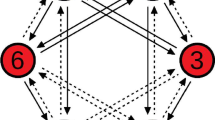Abstract
Coupled cell systems are networks of dynamical systems (the cells), where the links between the cells are described through the network structure, the coupled cell network. Synchrony subspaces are spaces defined in terms of equalities of certain cell coordinates that are flow-invariant for all coupled cell systems associated with a given network structure. The intersection of synchrony subspaces of a network is also a synchrony subspace of the network. It follows, then, that, given a coupled cell network, its set of synchrony subspaces, taking the inclusion partial order relation, forms a lattice. In this paper we show how to obtain the lattice of synchrony subspaces for a general network and present an algorithm that generates that lattice. We prove that this problem is reduced to obtain the lattice of synchrony subspaces for regular networks. For a regular network we obtain the lattice of synchrony subspaces based on the eigenvalue structure of the network adjacency matrix.









Similar content being viewed by others
Notes
\(V_k\) is a subspace of \(\ker \left( A- \lambda _i \mathrm{Id}_n\right) ^k\).
\(<B_C> \subseteq \ker \left( A- \lambda _i \mathrm{Id}_n\right) ^{k-1} \subseteq V_k\).
If row \(r_j-r_k\) of \(\overline{M}\) is zero, then \(x_j=x_k\) for all vectors in \(V_k\).
Equivalently, \(C_N\) is the set of equality conditions satisfied by the vectors in \(<\overline{\overline{B}}_k>\).
See Remark 6.7.
References
Aldis, J.W.: A polynomial time algorithm to determine maximal balanced equivalence relations. J. Bifur. Chaos Appl. Sci. Eng. 18(2), 407–427 (2008)
Aguiar, M., Ashwin, P., Dias, A., Field, M.: Dynamics of coupled cell networks: synchrony, heteroclinic cycles and inflation. J. Nonlinear Sci. 21(2), 271–323 (2011)
Aguiar, M.A.D., Dias, A.P.S., Golubitsky, M., Leite, M.C.A.: Bifurcations from regular quotient networks: a first insight. Physica D 238(2), 137–155 (2009)
Aldis, J.W.: On Balance, Phd Thesis, University of Warwick (2009)
Davey, B.A., Priestley, H.A.: Introduction to Lattices and Order. Cambridge University Press, Cambridge (1990)
Field, M.: Combinatorial dynamics. Dyn. Syst. 19(3), 217–243 (2004)
Gohberg, I., Lancaster, P., Rodman, L.: Invariant Subspaces of Matrices with Applications. Wiley, New York (1986)
Golubitsky, M., Stewart, I.: The Symmetry Perspective: From Equilibrium to Chaos in Phase Space and Physical Space, Progress in Mathematics 200. Birkhäuser, Basel (2002)
Golubitsky, M., Stewart, I.: Nonlinear dynamics of networks: the groupoid formalism. Bull. Am. Math. Soc. 43(3), 305–364 (2006)
Golubitsky, M., Stewart, I., Török, A.: Patterns of synchrony in coupled cell networks with multiple arrows. SIAM J. Appl. Dyn. Syst. 4(1), 78–100 (2005)
Järvinen, J.: Lattice theory for rough sets. In: Transactions on Rough Sets VI. Lecture Notes in Computer Science 4374, pp. 400–498. Springer, Berlin (2007)
Kamei, H.: Construction of lattices of balanced equivalence relations for regular homogeneous networks using lattice generators and lattices indices. Int. J. Bifur. Chaos Appl. Sci. Eng. 19(11), 3691–3705 (2009)
Leite, M.C.A., Golubitsky, M.: Homogeneous three-cell networks. Nonlinearity 19, 2313–2363 (2006)
Stewart, I.: The lattice of balanced equivalence relations of a coupled cell network. Math. Proc. Cambridge Philos. Soc. 143(1), 165–183 (2007)
Stewart, I., Golubitsky, M., Pivato, M.: Symmetry groupoids and patterns of synchrony in coupled cell networks. SIAM J. Appl. Dyn. Syst. 2, 609–646 (2003)
Acknowledgments
The authors thank the referees for their comments, which improved the paper’s presentation. Research was partially funded by the European Regional Development Fund through the program COMPETE and by the Portuguese Government through the FCT under Projects PEst-C/MAT/UI0144/2011 and PTDC/MAT/100055/2008.
Author information
Authors and Affiliations
Corresponding author
Additional information
Communicated by P. Newton.
Rights and permissions
About this article
Cite this article
Aguiar, M.A.D., Dias, A.P.S. The Lattice of Synchrony Subspaces of a Coupled Cell Network: Characterization and Computation Algorithm. J Nonlinear Sci 24, 949–996 (2014). https://doi.org/10.1007/s00332-014-9209-6
Received:
Accepted:
Published:
Issue Date:
DOI: https://doi.org/10.1007/s00332-014-9209-6




